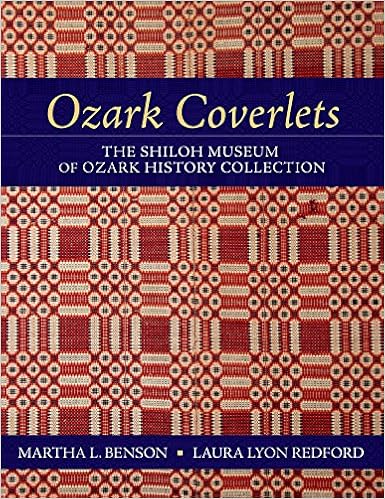I purchased this beauty on ETSY recently, and I've been trying to identify the pattern and weave structure. I poured through my pattern weaving books for 4-shafts, and never really came up with anything that seemed to match. I know it's overshot by the smaller background threads, and the thicker red pattern thread.
I am learning as I collect ... Woven coverlets were typically made in the home by women. A home weaver typically made only 1 or 2 in her lifetime, after spinning the fibers herself. Materials were cotton or linen for warp, and wool for the pattern weft. Cotton for the stabilizing weft. Often they would grow the cotton and raise the sheep, process the fiber and spin it into usable yarn so they could weave.
I stumbled on the following 2 videos about Ozark coverlets ... I learned a lot, and will likely get the book, Ozark Coverlets because it actually contains the pattern drafts if I wanted to recreate any of the featured coverlets. Other books on the subject do not seem to go as far as including the patterns.
Uncovering Ozark Coverlets -- But Wait, There's More! - Shiloh Museum of Ozark History (2020)
Marty Benson and Laura Redford, founders of the Ozark Coverlet Project
to document historic woven coverlets found in the region's museums and
private collections, share their latest discoveries. Recorded October
16, 2019.
Uncovering Ozark Coverlets - Shiloh Museum of Ozark History (c2019)
Marty Benson and Laura Redford, members of the Northwest Arkansas
Handweavers Guild, share findings from their study of some three dozen
hand-woven coverlets in the Shiloh Museum collection. Benson and Redford
are experienced weavers and weaving instructors with an interest in
history and historic textiles, and both are volunteers at the Shiloh
Museum. Recorded January 15, 2014.
Back to trying to figure out this pattern ...
I know it's overshot -- which was very popular in the 1800s ... not saying it's that old, though ... when women had to weave all the linens for the household because you could not go to Target or Walmart, or even Sears in an earlier day to purchase them ready made.
Here's a shot of the center seam, showing that it was woven in panels and then pieced together to make it wider --- Which is what I'll have to do if I want to make coverlets on my beloved Kessenich Floor Loom who's weaving width is only 29 inches.
It's quite heavy, and the red yarn is scratchy -- I'm assuming it's wool, but I haven't done a burn test to know for sure. I'm so used to the wool I spin today being soft and cuddly (That's alpaca!). I poured through the weaving pattern books I have for 4-shaft looms, but didn't really see anything that matched.
I finally had to post pictures on a FB Group and crowd-source the answer. Results were mixed (lots of things that didn't make sense amid some things that sort of did, but not quite), so I finally asked my local weaving friend (who has an engineering mind, and the source of my Kessenich 4-shaft loom) and she narrowed it down to Rosepath in a 2/2 twill weave structure--maybe Italian Diamond(?), and it looks like the weaver had fun with treadling and stretched out some of the designs to be whatever she wanted: "Weaver's Delight." It has two panels sewn together, and she did a marvelous job of matching things up so it wasn't just random. She must have planned it to match in the 2nd panel so well. Kind of exciting to learn new things, amid old things!
Another weaver suggested that it is Rosepath woven in an overshot technique. She recommended that I read the Rosepath chapter in the Davidson book, as well as the beginning fo the Overshot chapter, and how to build Overshot from regular 4-harness patterns. Apparently, you can elongate any pattern by adding tabby.
So when put the question out on two of the FaceBook Weaving Groups I'm part of, I got back quite a variety of answers earlier in the summer ... Finally, Janet Dawson spied it and went so far as to work up a draft for it, including the wif file. I was going to try it on the wkd, but she did it for me. Easy for her to do! I would have struggled ...
My friend Lynda C. thought it was a Rosepath, possibly the Italian Diamonds draft from A Hand Weaver's Pattern Directory by Marguarite P. Davison, p. 127.






.jpeg)
1 comment:
Your journey with coverlets has been interesting to follow. I learned a little about coverlets early on in my exploration of antique quilts, particularly from a book I bought featuring quilts and coverlets from a specific museum. Without heading upstairs and checking my bookcase, I can't tell you which museum it was but probably the Metropolitan Museum. Anyway, it taught me a few basics about coverlets like the things you are mentioning - the two panels and overshot weaving. Undoubtedly they have not gotten the recognition they deserve but you are adding to the knowledge base!
Post a Comment